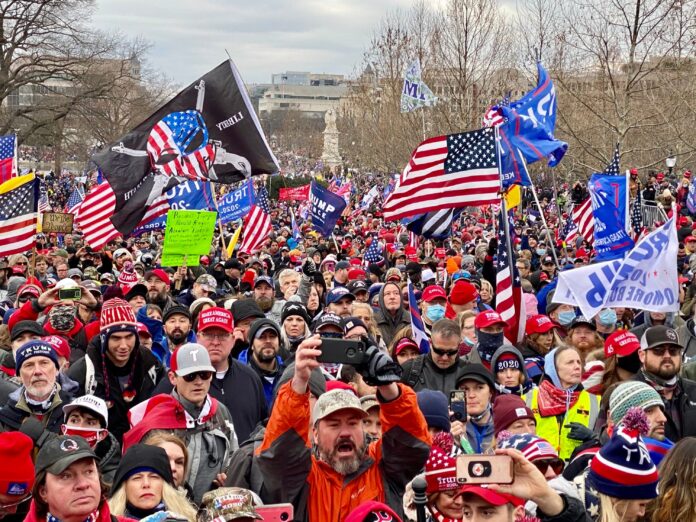The TError management Theory may be the best explanation for the MAGA movement
One reason the current presidential election campaigning has brought out the worst in American politics and journalism and focused extreme attention on the deficiencies of the nation’s justice and economic systems is undoubtedly the rise of the Tea Party, the 2007 recession, Congressional ineptitude, and the reality that Americans now get the best government money can buy.
However, there is also a little-known psychological theory that does an excellent job of explaining the rise of nationalism and American jingoism, which is hard-wired into our cognitive abilities and intelligence. This process is standard for all humans and is based on the looming and terrifying awareness that we will all die someday.
Awareness of our mortality and physical limitations has led to a conscious ability to contemplate our deaths. This terrifying and existential awareness is often too much for people to comprehend, so we have developed elaborate coping mechanisms to deal with the inevitability of death and the unanswerable questions dealing with an afterlife.

Cultural anthropologist Ernest Becker developed the Terror Management Theory (TMT) to help explain what happens when our self-awareness is confronted with the inevitability of our mortality and vulnerabilities. TMT develops unconsciously and works at several different psychological levels. However, when uncertainty and fear become very significant, people tend to seek collective psychological protection by adhering to a shared cultural view of beliefs individuals and groups share.
With this as a backdrop to explaining the current scary political environment, TMT produces some outcomes that are especially relevant to the contemporary scene.
As quoted in The Other Side of Sadness, by George A. Bonanno, a professor of clinical psychology, these outcomes emerge in the “belief that individual rights are more important than any other ethical concern, or that our country and political system are better than any other country and political system.”
Bonanno says people adopt these prejudiced beliefs because they provide meaning, value, and order in an uncertain, changing world. This comforts believers since they are now part of a larger group that shares those values. Being part of a larger group or cultural system also fosters the belief that the values and beliefs of its members will live on long after they have passed away.
Trump says: “Make America Great Again,” but his supporters hear: “Make Me Great Again”
In a fascinating 2008 interview in Scientific American, Sheldon Solomon, a professor of psychology at Skidmore College, cited Max Weber’s study of charismatic leadership, which “proposed that in times of crisis, when fears of death are aroused, people are more likely to embrace leaders who provide psychological security by making their citizens feel like they are valued contributors to a great mission to eradicate evil.”
 Solomon also said when citizens are publicly reminded of their deaths and vulnerability, they will more readily follow a leader who offers a clear direction, even if it is for a confused cause. This helps explain George Bush’s great popularity following the September 11 attacks on the World Trade Center when he said the U.S. was going on a “crusade” to “rid the world of evildoers.”
Solomon also said when citizens are publicly reminded of their deaths and vulnerability, they will more readily follow a leader who offers a clear direction, even if it is for a confused cause. This helps explain George Bush’s great popularity following the September 11 attacks on the World Trade Center when he said the U.S. was going on a “crusade” to “rid the world of evildoers.”
Of course, not all of these messages must be articulated to group members, but being in a group produces a welcoming familiarity that allows its members to speak in code. For instance, when others see a car with a Trump bumper sticker, it conveys meaning to others who might share those same political beliefs. As simple as it seems, “this feeling, in turn, gives us a sense of being immortal.”
Make America Great Again = Make Me Great Again.
An example of this projected good feeling comes directly from Trump’s signature campaign slogan. The “Make America Great Again” is a pitch for nostalgia from some past decade (never specified) when America was “great,” according to Trump’s view of history. But since the 1970s, starting with the Ronald Reagan presidency, wages have stagnated, public facilities began to be privatized, pensions were looted to fund corporate takeovers, and neo-liberalism began to erode the joint space.
For many of Trump’s followers, this was the beginning of the slow decline of the middle class as new trade deals (NAFTA) exported good-paying manufacturing jobs. This was followed by the 2008 recession, which wiped out trillions in home equity and destroyed the credit of millions of Americans.
Faced with this vast wealth loss and a stagnant job and wage market, many Americans, including many who became Trump followers, began to distrust the political and corporate capitalist system. While it was not articulated, people started looking for something optimistic to restore their wealth and future economic prospects and empower them. In short, they wanted someone to make them feel good again about themselves and their futures.
This should have led many of these people to follow Bernie Sanders, who, as a political outsider, has the best program for restoring jobs and reigning in Wall Street’s criminal behavior. But Trump appealed to their basest instincts by saying immigrants had stolen their jobs, people in government were inept, American world dominance was threatened, and that he had some as yet undisclosed plan to bring jobs (all non-union, low-paying, and without benefits and Obamacare) back to the U.S.
The reality is that the old jobs will not return. If they did, they would be highly automated, and Trump’s blue-collar followers would have to be retrained to repair and operate robots. Gone forever are the old manufacturing jobs and union-influenced high wages that made it possible for a single-wage earner to support a family that was common in the Fifties and Sixties.
This is why Trump’s slogan of “Make America Great Again” is heard by his followers as “Help Make Me Great Again,” a nostalgia he can never fulfill.
TMT also posits that people who share these common beliefs also believe others share those same values. Of course, this is a false assumption, known by psychologists as a “false consensus,” it could be used to explain why there is violence at some political rallies when one group realizes that an opposing group is not part of their clan.
While this is only one aspect of a complex theory, TMT has not been mentioned in the political reporting surrounding the current presidential campaigning. However, it should be cited as a deep, almost primordial product of our evolutionary consciousness and intelligence still spilling into the streets today.











